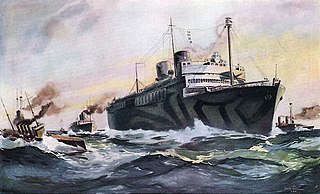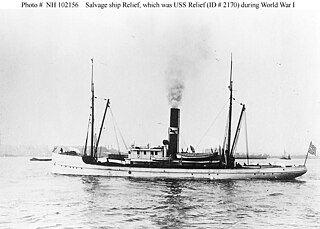
A paddle steamer is a steamship or steamboat powered by a steam engine that drives paddle wheels to propel the craft through the water. In antiquity, paddle wheelers followed the development of poles, oars and sails, where the first uses were wheelers driven by animals or humans.

The New York Shipbuilding Corporation was an American shipbuilding company that operated from 1899 to 1968, ultimately completing more than 500 vessels for the U.S. Navy, the United States Merchant Marine, the United States Coast Guard, and other maritime concerns. At its peak during World War II, NYSB was the largest and most productive shipyard in the world. Its best-known vessels include the destroyer USS Reuben James (DD-245), the cruiser USS Indianapolis (CA-35), the aircraft carrier USS Kitty Hawk (CV-63), the nuclear-powered cargo ship NS Savannah, and a quartet of cargo-passenger liners nicknamed the 4 Aces.

USS Sable (IX-81) was a United States Navy training ship during World War II, originally built as the passenger ship Greater Buffalo, a sidewheel excursion steamboat. She was purchased by the Navy in 1942 and converted to a training aircraft carrier to be used on the Great Lakes. She lacked a hangar deck, elevators, or armament and was not a true warship, but she provided advanced training of naval aviators in carrier takeoffs and landings.

Adirondack, a steel-hulled side-wheel river passenger steamship displacing 3,882 long tons (3,944 t), was built by J. Eaglis and Sons, at Greenpoint, Brooklyn, New York, in 1896, for the Hudson Navigation Company, the "People's Line". Her keel was laid 8 June 1895, and she was launched within five months, probably October 1895, with her fitting out completed in time for the summer 1896 season.

USS Siboney (ID-2999) was a ship transport for the United States Navy during World War I. She was the sister ship of USS Orizaba (ID-1536) but neither was part of a ship class. Launched as SS Oriente, she was soon renamed after Siboney, Cuba, a landing site of United States forces during the Spanish–American War. After her navy service ended, she was SS Siboney for the New York & Cuba Mail Steamship Co.. The ship was operated under charter by American Export Lines beginning in late 1940. During World War II she served the U.S. Army as transport USAT Siboney and as hospital ship USAHS Charles A. Stafford.

Demologos was the first warship to be propelled by a steam engine. She was a wooden floating battery built to defend New York Harbor from the Royal Navy during the War of 1812. The vessel was designed to a unique pattern by Robert Fulton, and was renamed Fulton after his death. Because of the prompt end of the war, Demologos never saw action, and no other ship like her was built.
USS Zouave was a steamer acquired by the Union Navy during the American Civil War. She was needed by the Navy to be part of the fleet of ships to prevent blockade runners from entering ports in the Confederacy.

USS O. M. Pettit was a steamer acquired by the Union Navy during the American Civil War. She was used by the Navy as a tugboat to service Union Navy ships blockading ports of the Confederate States of America.
USS Clara Dolsen was a large steamer captured by the Union Navy during the American Civil War. She served the Union Navy in river operations and as a "receiving ship" auxiliary.

USS Polaris, originally called the America, was an 1864-screw steamer procured by the Union Navy as USS Periwinkle during the final months of the American Civil War. She served the Union Navy's struggle against the Confederate States as a gunboat.

The fourth USS Relief (ID-2170) was a salvage tug that served in the United States Navy from 1918 to 1919.

The first USS Willoughby (SP-2129) was a patrol vessel that served in the United States Navy from 1918 to 1919.

The first USS Sappho (ID-1427) was a United States Navy ferry transport in commission from 1918 to 1919.
USS Nina was a United States Navy steamer commissioned in 1866. She served in a variety of roles — as a tug, torpedo boat, torpedo boat tender, salvage ship, supply ship, and submarine tender — before she sank in a storm in 1910.

The second USS Hiawatha was a harbor tug that served in the United States Navy in 1918.
USS Freehold (SP-347) was a minesweeper and tug that served in the United States Navy from 1917 to 1919.
USS Little Brothers (SP-921) was a United States Navy tug in commission from 1917 to 1919.

USS Smith Briggs was a Union Army gunboat destroyed during the American Civil War.












